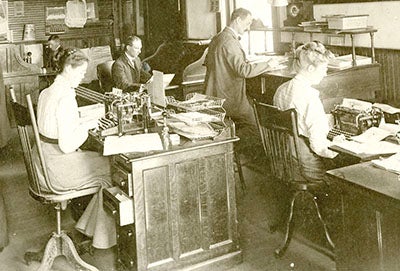Story of a house
Published 8:01 am Sunday, September 10, 2017
After nearly five years at the Hormel Historic Home, I have heard many questions regarding the Hormel family, the architecture of the house, and the decor within.
Quite frequently features are pointed out to me that I have never noticed or considered which makes me curious and motivated to research. For the rest of September, I thought I would share some FAQ’s and the results of my research.
Guests often comment on the typewriter that sits on the desk in “George’s office” and marvel how far technology has come. Kids are drawn to the heavy metal contraption because the keys offer them an experience with a technology they possibly haven’t seen before.
The relic on display is a rebuilt L.C. Smith model No. 8 with a 10-inch carriage that dates to about 1925. It still works, but with a ribbon of unknown age and unreliable quality. The history of this typewriter belongs to the Lyman C. Smith family of Syracuse, New York. With the help of his three brothers, Wilbert, Monroe and Hurlbut, Lyman started the Smith Premier Typewriter Company in 1886 which became the L.C. Smith and Brothers Typewriter Company in 1903. Smith’s first machine was manufactured in his shotgun factory. Based on the success of the typewriter, the company ceased making guns in 1888 and turned all their attention to their new machine.

The photo included above shows the 1902 office of the George A. Hormel and Company. Notice the ladies at the typewriters. My best theory is that the typewriter being used is a Remington Standard No. 7 which was fitted with 42 keys in an effort to accommodate foreign language keyboards as well as other keys commonly used on English keyboards.
George Hormel was progressive in business so when new appliances came along to help with efficiency I am sure he embraced them. He wrote about the laborious work he and his wife Lillian engaged in during the early days of the Hormel Company. “After the day’s work at the plant was over, my wife and I spent our evenings on paper work. We made price lists on a homemade hectograph. An impression of the hand-lettered original was transferred to gelatin shaped in one of her square broad pane. We billed customers, wrote letters, addressed circulars, kept books, and figured payrolls until bedtime.” The invention of modern equipment gave him more time to focus on meeting the needs of customers instead of in the mire of time consuming tasks.
The Smith family legacy-four brothers working hard to build a company based on innovation and resilience-reminds me of the Hormel family. Both companies were led by hard working men who built successful businesses with the help of their family members and who influenced the industries in which they succeeded.
History Happy Hour:
Austin’s Other Historic Homes, Part 2
5:30 p.m. social, 6 p.m. presentation Monday
Free for members of HHH, Friends of the Library and the Mower County Historical Society. $5 for non-members
Hearth & Home Series: Smoothies — Let Food Be Thy Medicine
10 a.m., Tuesday
Join Megan Groh, your Austin Hy-Vee dietitian to learn everything you wanted to know about smoothies. You will learn how to build nutritionally dense smoothies, sample different smoothies and take home new ideas and recipes.


